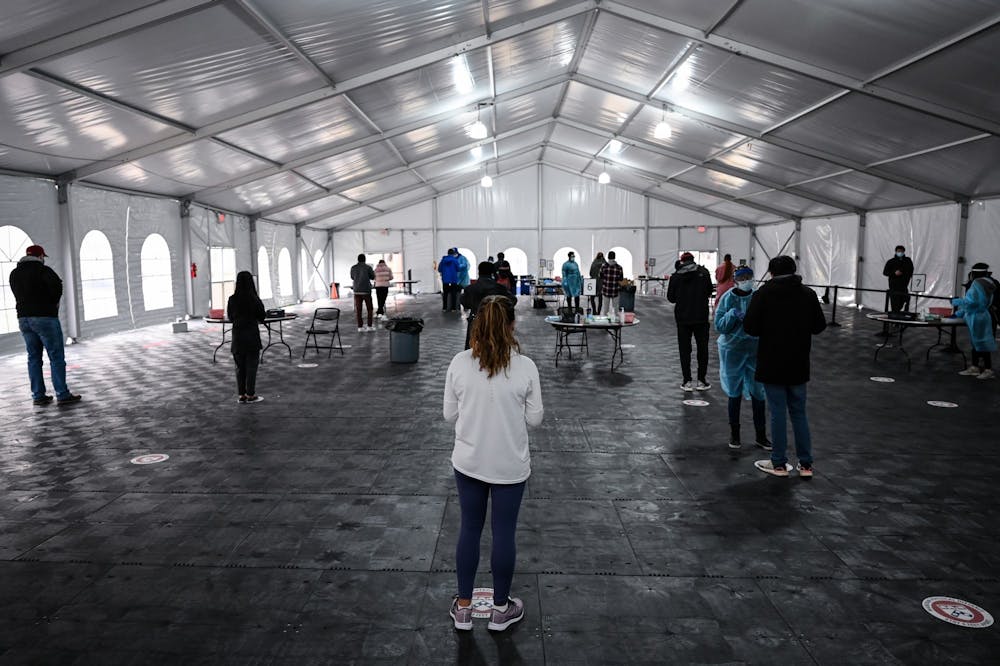
Positive COVID-19 cases among undergraduate students skyrocketed during the week from Jan. 23 to Jan. 29, nearly tripling in number from the previous week and ending optimistic trends needed for a return to the normal policy on indoor social gatherings.
Among Penn community members, cases declined overall, mirroring trends of lowering cases throughout Philadelphia County. The University wrote on the COVID-19 Dashboard that the surge in cases among undergraduate students is likely linked to the tail end of gateway testing, and that encouraging trends are expected to return next week.
A total of 676 community members tested positive for COVID-19 during the week of Jan. 23 to Jan. 29 — up from 484 the week before — breaking a three-week declining trend in positive cases.
The campus-wide COVID-19 positivity rate remained essentially unchanged, reaching 4.72% among all community members during the week from Jan. 23 to Jan. 29. — increasing slightly from 4.21% during the week from Jan. 16 to Jan. 22.
The vast majority of positive cases came from the undergraduate community, which composed 483 of the positive tests during the week from Jan. 23 to Jan. 29. The undergraduate positivity rate sharply increased to 9.68% — up from 4.09% last week.
In a Feb. 1 email to all Penn students, Chief Wellness Officer Benoit Dubé and Vice Provost for University Life Mamta Motwani Accapadi announced that the restriction on indoor social gatherings and event registration remains on hold, citing the doubling of COVID-19 positivity among undergraduate students. The ban was first instituted at the end of the fall 2021 semester.
“We are confident that in the coming week or two, positivity rates will decrease to a level that will permit normal operations,” Dubé and Accapadi wrote, adding that they will reassess the on-campus positivity rates on a week-by-week basis to determine whether to permit public gatherings and event registration.
Dubé and Accapadi clarified that students are still allowed to gather indoors in order to attend class, study, spectate at athletic events, and hold meetings and events. All students must follow Penn’s current Public Health Guidance, which requires either double-masking or using a KN95 or N95 mask when inside all campus buildings and facilities. The University encourages all students to continue utilizing outdoor spaces for daily activities and remain masked when doing so.
“We can only imagine how disappointing this decision may be,” Dubé and Accapadi wrote. “Know that these decisions are not easy to make, and we look forward to recapturing this part of the campus experience as soon as it is safe to do so.”
More community members took COVID-19 tests in the past week — with a six-week high of 14,321 — as part of the University’s spring semester gateway testing policy. The policy required all students, faculty, staff, and postdoctoral students to receive a COVID-19 test through Penn upon campus arrival through the end of January. Students who have not yet taken a gateway test are at risk of being under registration hold, impacting their ability to select and change courses.
Following the conclusion of the gateway testing program, all students are required to participate in the Penn Cares screening testing program. Fully vaccinated students are required to test once every other week, and unvaccinated community members are required to test twice each week.
All community members will have access to COVID-19 tests, which can be taken at Du Bois/Rodin Field or Houston Hall.
Community members who have tested positive for COVID-19 within the past 90 days are exempt from screening testing but are required to continue reporting symptoms and exposures through PennOpen Pass.
The number of students in isolation also decreased for a third consecutive week, dropping from 564 to 426, far lower than the record high of 1,316 during the week from Jan. 9 to Jan. 15. Following a continued expansion of the University’s isolation housing portfolio, on-campus isolation capacity remains high with 60.3% availability — down from 77.2% the prior week.
Director of Campus Health Ashlee Halbritter told The Daily Pennsylvanian on Jan. 27 that the University has been responsive to complaints from students living in on-campus isolation housing. Recent changes to the isolation housing experience include termination of the usage of old fraternity and sorority houses, changes in how students in isolation can safely order and receive food, and ensuring that students who need to stay in isolation dorms receive proper moving instructions.
Wharton first-year Max Matolcsy tested positive for COVID-19 on Jan. 24 and received same-day guidance via email from Penn with instructions on how to move to isolation housing at the Axis Apartments. The email included information on what to pack, how to connect to Wi-Fi, and how to order meals.
"Since I was living in the Axis Apartments, I was only able to order from Axis Pizza," Matolcsy said, adding that he was also only allowed two meals a day and both orders had to be placed by 10 a.m.
"It's definitely not enough food to feed a person for a whole day,” said Matolcsy, who said he ended up spending money to get additional food delivered through Uber Eats and ordering groceries to the apartment. “It is very hard to find good, healthy things to eat for five days from a pizza restaurant,” he said.
Matolcsy also said the water distribution system was poorly organized. He explained that to get bottled water, he would have to continuously go to the first floor to ask someone for water. On several occasions, they were out of bottled water, and Matolcsy returned to his room with nothing.
The Daily Pennsylvanian is an independent, student-run newspaper. Please consider making a donation to support the coverage that shapes the University. Your generosity ensures a future of strong journalism at Penn.
Donate







